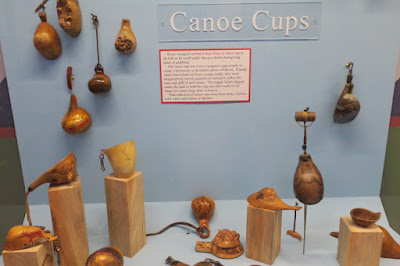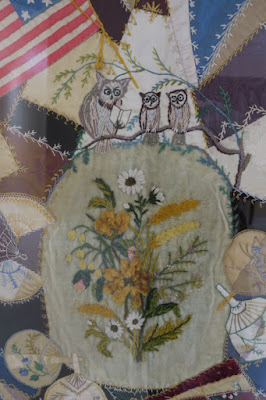North and up we went this morning headed to the Black Hills of South Dakota.
We interrupted our journey for a visit to the Museum of the Fur Trade in Chadron, NE. Duane had visited here once in the 1980's and was amazed to find that the whole thing had been expanded and updated and made into a first-rate museum.
We are always impressed with details, like hand-forged door pulls that fit the time period.
When people hear "fur trade" they immediately think beaver fur. The actual fur trade continued after beaver fur went out of fashion.
Hats were the favorite item made from beaver.
Furs of all kinds were traded for all kinds of personal items such as eye wear,
clothing
Indian made porcupine quill moccasins. The ones on either side are beaded.
European fabric,
blankets. The Hudson Bay Co tried to establish a standard by marking blankets by size. The four lines in the green blanket was a large blanket thought to be worth 4 beaver pelts, the red one, a lap throw, only two pelts. Nobody paid much attention to it and continued to trade their own way.
Mountain men traded such things as metal items and tobacco for exquisite Indian embroidered, quill worked, or beaded items.
guns and ammo were hot ticket items to be traded for furs.
After the bottom fell out of the beaver market, trade continued.
A diorama demonstrating the above three pix. Notice the guy leaning over the side dipping his cup for a drink.
The fur trade continues in modern times. The director and costume designers of the movie The Revenant consulted with The Museum of the Fur Trade for time period accuracy.
Farm raised fur-bearing animals and modern techniques can make use of what was formerly considered waste fur. I'd wear that 'coat of many colors', which is set against a backdrop of a skunk skin blanket.
After touring this wonderful museum we were ready to pass through these awesome wood doors to visit
As trade progressed, trade goods in this warehouse swapped places with bales of buffalo hides or robes.
Trade room and living quarters
One robe could buy 50 bullets and 1 lb of powder, a knife or 5 yds of cotton print fabric.
The door leads to the living quarters.
Robe press. In an average winter, the trading post took in a thousand well-tanned buffalo robes which were sold in the east for bed covers, lap robes for traveling, and overcoats. To facilitate storage, shipping and accounting, the robes were baled into bundles of ten. Each robe was folded into a 2'x3' size, hair side in. Several men pressed the bar down while another pulled ropes tight around the bale and tied them.
We thoroughly enjoyed our side trip to this museum. Duane and I met at a modern recreation of a rendezvous. The sight of buckskins and moccasins, trade cloth and bead work brought back many fond memories. We thought the museum was well worth 2 hours out of our travel day. We recommend it as a travel stop for anyone in the area.
Tomorrow you can see where we stopped.
Louise and Duane























































